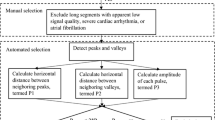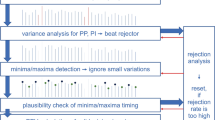Abstract
Objective. Continuous blood pressure (BP) measurement provides instantaneous information on hemodynamic status, and allows for assessment of sympathetic modulation of vasomotor tone using spectral analysis. As an alternative to intraarterial blood pressure (IABP) measurement, the Finapres, a photoplethysmographic device, allows for non-invasive continuous measurement of finger blood pressure (FBP). This study was designed to evaluate the accuracy of spectral measurements of FBP variability in children during anesthesia and recovery. For this purpose, reliability of BP measurement and short-term BP variability assessed by FBP were calculated and compared with IABP. Methods. Finger blood pressure was compared with IABP from the ipsilateral radial artery, in 14 children undergoing major surgery. Sixty-seven simultaneous recordings of both signals were performed during anesthesia and 32 during recovery period. The accuracy of the FBP was determined by measuring its bias and precisi on according to the Bland and Altman method. To assess the ability of the FBP to follow short term BP variability, bias of total spectral power and bias of the 3 main spectral components (LF, MF, HF) were calculated. Transfer functions between invasive and non-invasive signals were calculated. Results. The average bias of SBP measurement was 3.8 ± 7.4 mmHg during anesthesia and 2.2 ± 6.7 mmHg during recovery. During anesthesia overall variability and spectral components of FBP and IABP were similar with both techniques; while during recovery, a selective amplification of the low frequencies (<0.15 Hz) of FBP was observed. Frequency response analysis of the pressure waveform, showed a high coherence between both signal with a gain of 0.96 ± 0.52 mmHg FBP/mmHg IABP under anesthesia, and of 0.74 mmHg FBP/mmHg IABP during recovery. Conclusions. The differences evidenced between FBP and IABP spectral profiles might result from specific physiological properties of dig ital arteries, which are sympathetic effectors. This study supports the use of FBP in children to assess non-invasively the vascular sympathetic component of the autonomic nervous system during anesthesia and recovery.
Similar content being viewed by others
REFERENCES
Pagani M, Montano N, Porta A, Malliani, Abboud FM, Birkett C, Somers VK. Relationship between spectral components of cardiovascular variabilities and direct measures of sympathetic nerve activity in humans. Circulation 1997; 95: 1441–1448
Rooke GA, Schwid HA, Shapira Y. The effect of graded hemorrhage and intravascular volume replacement on systolic pressure variation in humans during mechanical and spontaneous ventilation. Anesth Analg 1995; 80: 925–930
Mangano DT, Hickey RF. Ischemic injury following uncomplicated radial artery catheterization. Anesth Analg 1979; 58: 55–57
Penaz J. Photoelectric measurement of blood pressure, volume and flow in the finger. Digest 10th Int Conf Med Biol Eng, Dresden 1973; 104.
Wesseling KH, Settles JJ, De Wit B. The measurement of continuous finger arterial pressure noninvasively in stationary subjects. In: Schmidt TH, Dembroski TM, Bluemchen G, eds: Biological and psychological factors in cardiovascular disease. Berlin: Springer-Verlag, 1986: 355–375
van Egmond J, Hasenbos M, Crul JF. Invasive versus non-invasive measurement of arterial pressure. Comparison of two automatic methods and simultaneously measured di-rect intra-arterial pressure. Br J Anaesth 1985; 57: 434–444
Epstein RH, Bartkowski RR, Huffnagle S. Continuous noninvasive finger blood pressure during controlled hypotension. A comparison with intraarterial pressure. Anesthesiology 1991; 75: 796–803
Aitken HA, Todd JG, Kenny GN. Comparison of the Finapres and direct arterial pressure monitoring during profound hypotensive anaesthesia. Br J Anaesth 1991; 67: 36–40
Stokes DN, Clutton-Brock T, Patil C, Thompson JM, Hutton P. Comparison of invasive and non-invasive measurements of continuous arterial pressure using the Finapres. Br J Anaesth 1991; 67: 26–35
Gibbs NM, Larach DR, Derr JA. The accuracy of Finapres noninvasive mean arterial pressure measure-ments in anesthetized patients. Anesthesiology 1991; 74: 647–652
Wilkes MP, Bennett A, Hall P, Lewis M, Clutton Brock TH. Comparison of invasive and non-invasive measure-ment of continuous arterial pressure using the Finapres in patients undergoing spinal anaesthesia for lower segment caesarean section. Br J Anaesth 1994; 73: 738–743
Imholz BP, van Montfrans GA, Settels JJ, van der Hoeven GM, Karemaker JM, Wieling W. Continuous non-inva-sive blood pressure monitoring: Reliability of Finapres device during the Valsalva manoeuvre. Cardiovasc Res 1988; 22: 390–397
Parati G, Casadei R, Groppelli A, Di Rienzo M, Mancia G. Comparison of finger and intra-arterial blood pressure monitoring at rest and during laboratory testing. Hyper-tension 1989; 13: 647–655
Imholz BP, Settels JJ, van der Meiracker AH, Wesseling KH, Wieling W. Non-invasive continuous finger blood pressure measurement during orthostatic stress compared to intra-arterial pressure. Cardiovasc Res 1990; 24: 214–221
Lindqvist A. Beat-to-beat agreement of non-invasive finger artery and invasive radial artery blood pressure in hypertensive patients taking cardiovascular medication. Clin Physiol 1995; 15: 219–229
Perry JC, Garson A Jr. The child with recurrent syncope: Autonomic function testing and beta-adrenergic hyper-sensitivity. J Am Coll Cardiol 1991; 17: 1168–1171
Constant I, Villain E, Laude D, Girard A, Murat I, Elghozi JL. Heart rate control of blood pressure variabil-ity in children: A study in subjects with fixed ventricular pacemaker rythm. Clin Sci 1998; 95: 33–42
Constant I, Dubois MC, Piat V, Murat I. Heart rate and blood pressure variability during halothane or sevoflur-ane anesthesia in children. Anesthesiology 1998; 89: A1253.
Triedman JK, Saul JP. Comparison of intraarterial with continuous noninvasive blood pressure measurement in postoperative pediatric patients. J Clin Monit 1994; 10: 11–20
Constant I, Girard A, Le Bidois J, Villain E, Laude D, Elghozi JL. Spectral analysis of systolic blood pressure and heart rate after heart transplantation in children. Clin Sci (Colch) 1995; 88: 95–102
Jaffe RS, Fung DL, Behrman KH. Optimal frequency ranges for extracting information on autonomic activity from the heart rate spectrogram. J Auton Nerv Syst 1994; 46: 37–46
Bland JM, Altman DG. Statistical methods for assessing agreement between two methods of clinical measurement. Lancet 1986: 307–310
Saul JP, Berger RD, Albrecht P, Stein SP, Chen MH, Cohen RJ. Transfer function analysis of the circulation: Unique insights into cardiovascular regulation. Am J Physiol 1991; 261: H1231-H1245
Robbe HW, Mulder LJM, Rüdel H, Langewitz WA, Veldman JBP, Mulder G. Assessment of baroreceptor reflex sensitivity by means of spectral analysis. Hyper-tension 1987; 10: 538–543
AAMI. Standard for electronic or automated phsyg-momanometers, in AAMI Standards. Arlington, VA: Association for the Advancement of Medical Instrumen-tation, 1980: 29–42
Imholz BP, Wieling W, Langewouters GJ, Van Montfrans GA. Continuous finger arterial pressure: Utility in the cardiovascular laboratory. Clin Auton Res 1991; 1: 43–53
Imholz BP, Wieling W, Van Monfrans GA, Wesseling KH. Fifteen years experience with finger arterial pressure monitoring: Assessment of the technology. Cardiovasc Res 1998; 38: 605–616
Wesseling KH, Settels JJ, Van der Hoeven MA, Nijboer JA, Butjin MWT, Dorlas JC. Effects of peripheral vaso-constriction on the measurement of blood pressure in a finger. Cardiovasc Res 1985; 19: 139–145
Bissonnette B, Sessler DI. The thermoregulatory threshold in infants and children anesthetized with iso-flurane and caudal bupivacaine. Anesthesiology 1990; 73: 1114–1118
Scheffer GJ, Ten Voorde BJ, Karemaker JM, Ros HH, de Lange JJ. Effects of thiopentone, etomidate and propofol on beat to-beat cardiovascular signals in man. Anaesthesia 1993; 48: 849–855
Ireland N, Meagher J, Sleigh JW, Henderson JD. Heart rate variability in patients recovering from general anaes-thesia. Br J Anaesth 1996; 76: 657–662
Omboni S, Parati G, Frattola A, Mutti E, Di Rienzo M, Castiglioni P, Mancia G. Spectral and sequence analysis of finger blood pressure variability. Comparison with analysis of intra-arterial recordings. Hypertension 1993; 22: 26–33
Novak V, Novak P, Schondorf R. Accuracy of beat-to-beat noninvasive measurement of finger arterial pressure using the Finapres: A spectral analysis approach. J Clin Monit 1994; 10: 118–126
Pinna GD, Maestri R, Mortara A. Estimation of arterial blood pressure variability by spectral analysis: Compar-ison between Finapres and invasive measurements. Physiol Meas 1996; 17: 147–169
Hayoz D, Tardy Y, Rutschmann B, Mignot JP, Achakri H, Feihl F, Meister JJ, Waeber B, Brunner HR. Sponta-neous diameter oscillations of the radial artery in humans. AmJ Physiol 1993; 264: H2080-H2084
Rizzoni D, Castellano M, Porteri E, Bettoni G, Muiesan P, Muiesan ML, Giulini SM, Cinelli A, Salvetti M, Agabiti Rosei E. Arterial spontaneous rhythmic con-tractile activity in humans and rats: Spectral analysis and regulatory mechanisms. J Hypertens 1995; 13: 1043–1052
Saul JP. Rea RF, Eckberg DL, Berger RD, Cohen RJ. Heart rate and muscle sympathetic nerve variability dur-ing reflex changes of autonomic activity. Am J Physiol 1990; 258: H713-H721
Bernardi L, Hayoz D, Wenzel R, Passino C, Calciati A, Weber R, Noll G. Synchronous and baroceptor-sensitive oscillations in skin microcirculation: Evidence for central autonomic control. Am J Physiol 1997; 273: H1867-H1878
Author information
Authors and Affiliations
Rights and permissions
About this article
Cite this article
Constant, I., Laude, D., Elghozi, JL. et al. Assessment of Short-Term Blood Pressure Variability in Anesthetized Children: A Comparative Study Between Intraarterial and Finger Blood Pressure. J Clin Monit Comput 15, 205–214 (1999). https://doi.org/10.1023/A:1009989130561
Issue Date:
DOI: https://doi.org/10.1023/A:1009989130561




